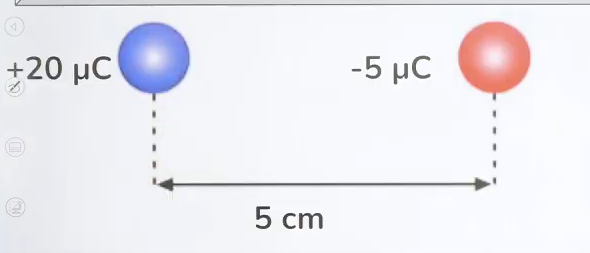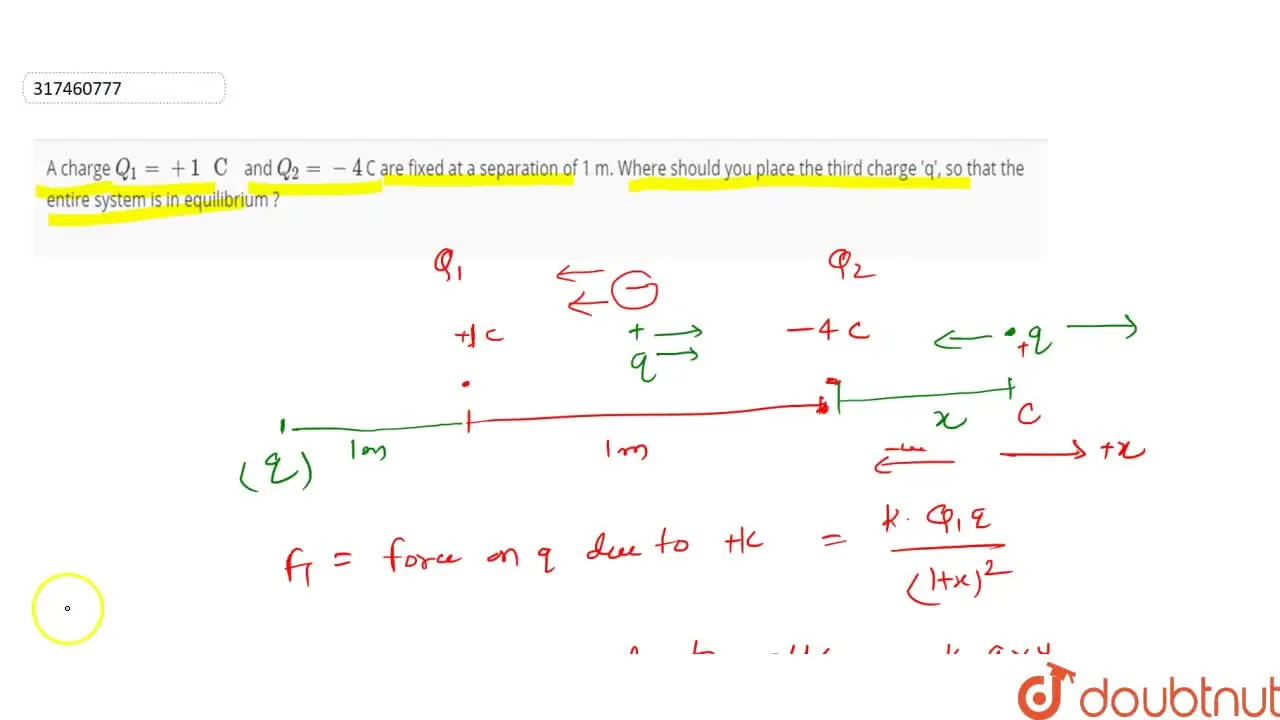A charge Q1=+1 C and Q2=−4 C are fixed at a separation of 1 m. Where should you place the third charge 'q', so that the entire system is in equilibrium ?
Shortcut method :
Here since Q1 and Q2 are of opposite nature, so the third charge q will be kept at a distance x to the left of Q1 and outside, because Q1 has less magnitude compared to Q2.

For Calculating x : Make the net force on q equal to zero. With the shortcut idea of placing q outside you can automatically see, whatever may be the sign of q, the force on it by Q1 and Q2 will be opposite direction, so we have to just balance the magnitude of forces
∴ kQ1qx2=kQ2q(1+x)2 or 1x2=4(1+x)2
Taking the square root gives 1x=21+x
∴ x=1 m
For calculating q : Make net force on Q1 (You could make on Q2 as well) equal to zero, as the entire system in equilibrium means, the net force on all the three charges due to each other is equal to zero. First of all, do you make out that q has to be negative because Q2 is negative. Only then Q1 will experience forces in opposite direction. Now just balance the magnitude of force on Q1.
Force due to q=kQ1qx2
Force due to Q2=kQ1Q212
Now, kQ1qx2=kQ1Q212∴qx2=Q212
Put x = 1 and Q2=4 (don.t take negative because you have to just balance the magnitude)
∴ q=4 C
but as we predicted in the beginning q has to be of negative sign so, final answer is q=−4C and x=1 m to the left of Q1.
Similar Questions
Two fixed charges are as shown. Where should the third charge be placed so that its in equilibrium?
 View Solution
View Solution(a) Two point charges Q and 16Q are fixed at separation d. Where should a third point charge be placed between them so that it experiences no force I.e. in equilibrium ?
(b) In the previous problem , if we replace Q by −Q , where should the third charge be placed on the joining the charges so that it is equilibrium ?
(c ) Three point charges Q,q and Q are placed at x=0,x=d/2 and x=d. Find q in terms of Q so that all charges are in equilibrium.
(d) Two point charges 9Q and 25Q are placed at separation d. Where should a third charge q be placed between them so that all charges are in equilibrium ? Also find the value of q and its nature.View SolutionTwo free charges q and 4q are placed at a distance d apart A third charge Q is placed between them at a distance x from charge q such that the system is in equilibrium. Then magnitude of third charge and postion,
View SolutionTwo free charges q and 4q are placed at a distance d apart A third charge Q is placed between them at a distance x from charge q such that the system is in equilibrium. Then
View SolutionA negative charge q1=50×10−9C and a positive charge q2=25×10−9C are fixed at a distance l=20cm. Where should a thrid charge q be placed on the line joining the charges so that they may be in equillibrium? What is the nature of equillibrium with respect to its longitudenal displacement along the line joiing the two charges? Plot a grapgh showing dependence of this force on distance from q∘.
View SolutionTwo points charges +4q and +q are separated by distance r, where should a third point charge Q be placed that the whole system remains in equilibrium
View SolutionTwo point charges +9e and +e are kept 16cm. Apart from each other. Where should a third charge q be placed between them so that the system is in equilibrium state:
View SolutionTwo point metal charges−q and +2q are placed at a certain distance apart.Where should a third point charge be placed so that it is in equilibrium?
View SolutionTwo point charges 2q and 8q are placed at a distance r apart. Where should a third charge −q be placed between them so that the electrical potential energy of the system is a minimum
View SolutionTwo point charges q1=+2C and q2=−1C are separated by a distance d. The position on the line joining the two charges where a third charge q=+1C will be in equilibrium is at a distance
View Solution


